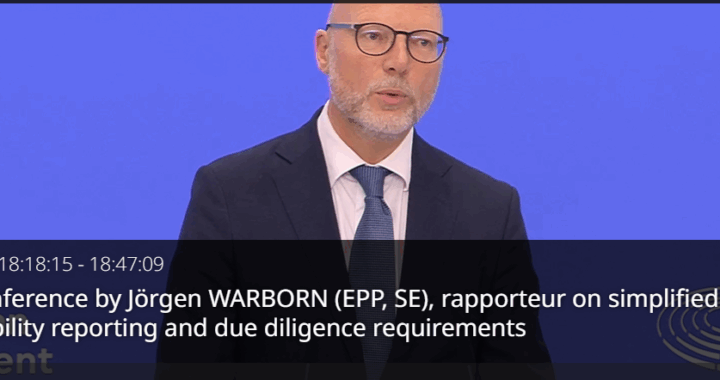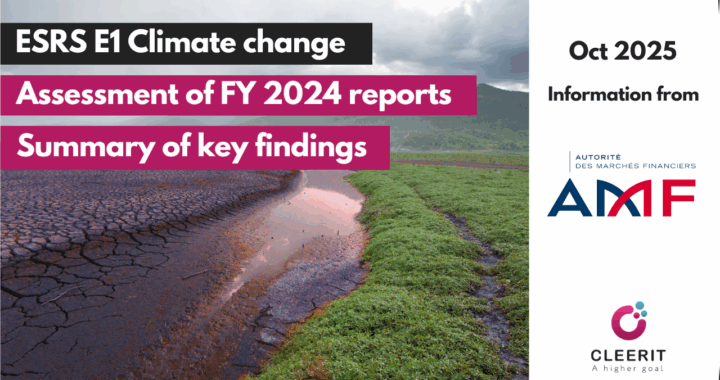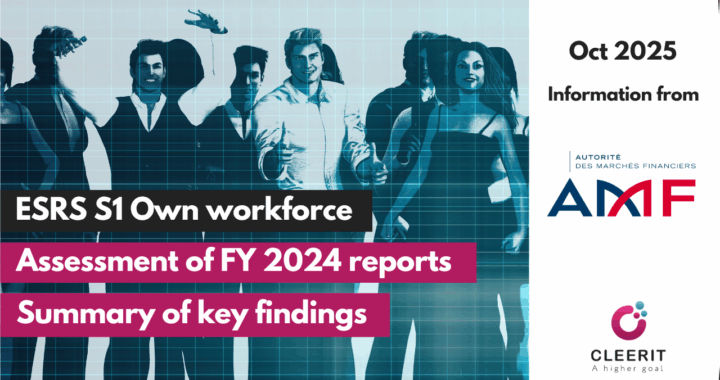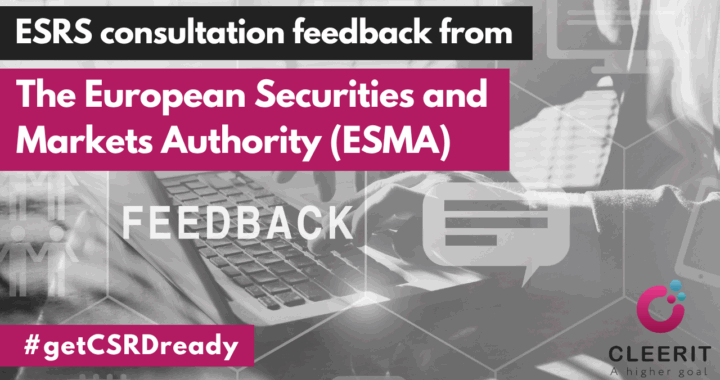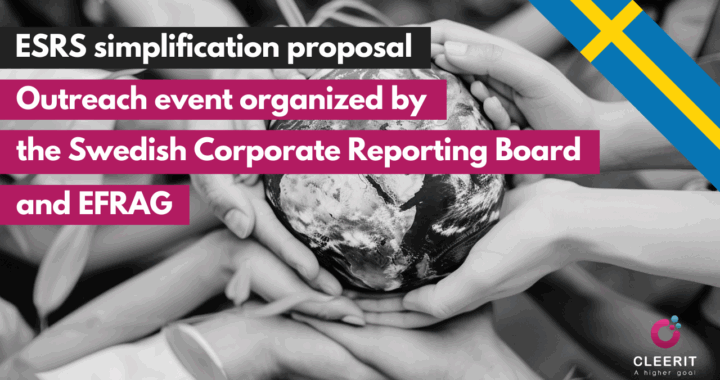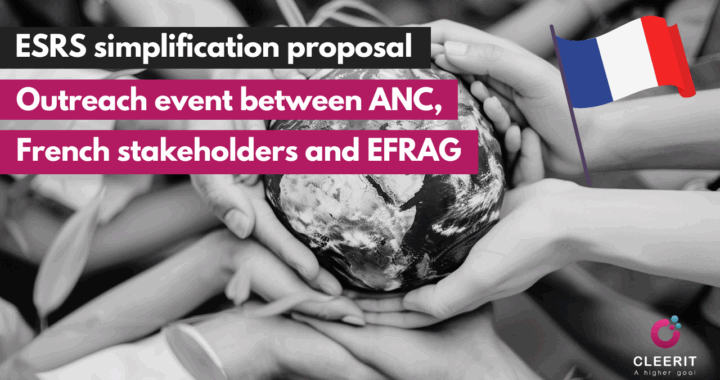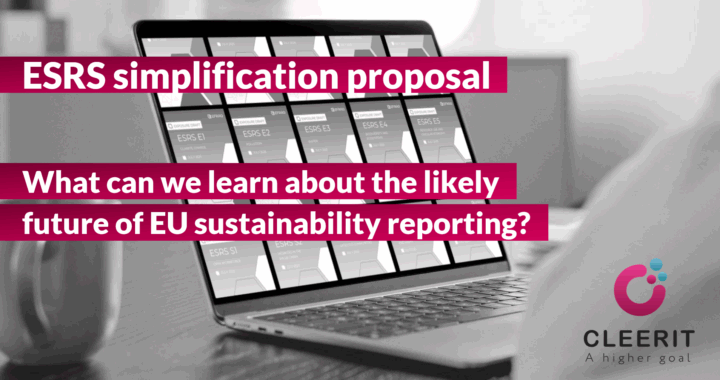A DEEP-DIVE INTO THE ESRS SIMPLIFICATION PROPOSAL DATED JULY 31, 2025
On July 31st, EFRAG proposed a simplified set of ESRS, drastically reducing datapoints while retaining the core objectives of the EU Green Deal.
This proposal is now open for public consultation until 29 September 2025. The revised ESRS drafts and the consultation survey are available here: https://www.efrag.org/en/amended-esrs-0
A deep-dive into the ESRS simplification proposal gives a clear indication of the likely future of EU sustainability reporting – which it’s here to stay.
It also highlights lessons learned from FY 2024 1st wave reporting, which did not always meet expectations, and gives us the keys to produce relevant, useful and compliant sustainability statements for FY 2025 and beyond.
The purpose of the enclosed document is to provide you with an insight into the proposed simplified set of ESRS, including EFRAG’s feedback from 1st wave reporting, to prepare for high-quality ESRS reporting.
We hope that it will be useful both for 1st wave companies preparing the FY25 report and for 2nd wave companies setting up a sustainability governance system to prepare for the FY27 report.
Here are some of our key takeaways from EFRAG’s ESRS simplification proposal (you will find further detailed in the full document):
Reduced by over 50% but still CSRD-compliant and retaining the core objectives of the EU Green Deal – how is this possible?
The overall length of the standards has been shortened by over 55% and the number of mandatory datapoints have been cut by 57%.
Yet the core content of the expected information necessary to fulfil CSRD obligations and the EU Green Deal objectives is still more or less intact. How is this possible?
A less prescriptive approach – increased management responsibility
First, EFRAG has proposed a less prescriptive approach with reduced granularity for narrative disclosures.
The objective of what the user of the report needs to understand from a specific disclosure is clearly spelled out, and from the application requirements (AR) and non-mandatory implementation guidance (NMIG) we learn what content should or could be expected from such a disclosure.
The standards then leave it up to management to include the relevant information – while complying with the required qualitative characteristics (complete, neutral, accurate, concise, comparable, verifiable …) and the materiality of information criteria (decision-usefulness, understanding of material IROs…).
While this provides more flexibility, the addition of the fair presentation requirement makes it crystal clear that management is responsible for the information it provides to the market.
Indeed, the standards implicitly acknowledge that to achieve fair presentation of the information, it may be necessary for management to provide disclosures beyond those specifically required by the standards.
Streamlined and focused, with less overlaps and duplications
Second, the standards have been streamlined, with less overlaps and duplications.
They are now structured around the standardization of the description of the core content across all topics, and sub-topics when relevant:
→ IROs, policies, targets, actions and metrics (with narrative context for both ESRS metrics and entity-specific metrics).
A paragraph has been added to explicitly clarify that fairly presenting material IROs is the objective of ESRS sustainability reporting. (ESRS 1, par 3)
The standards also clarify that information is material and needs to be included when (ESRS 1, par. 21):
(a) omitting, misstating or obscuring that information could reasonably be expected to influence decisions that primary users of general-purpose financial reports make based on those reports, including financial statements and the sustainability statement; or
(b) it is necessary for users of general-purpose sustainability statements to understand the undertaking’s material impacts, risks and opportunities [IROs] and how it identifies and manages them [with policies, actions, targets and metrics].
We need to report on a given topic when the topic relates to one or more material IROs, as identified through the double materiality assessment. (ESRS 1, par. 22)
The description of the material IROs shall make it explicit which policies, actions and targets relate to which material IROs. (ESRS 1, par. 113)
So, identifying IROs, incl where and how they arise throughout the entire value chain, through a compliant double materiality assessment, and explaining how material IROs are managed with clear reference to connected policies, actions, targets and metrics, as a basis for a robust sustainability governance, is still very much the focus of the simplified ESRS.
But, acknowledging that we are still in a learning curve and building new capabilities, reliefs have been including to allow for reporting with information available at the reporting date “without undue cost or effort”, while requiring transparency and the disclosure of the actions taken to increase coverage and quality in future reporting periods, and the progress compared to the previous reporting period. (ESRS 1, par. 87 and 91)
Lessons learned from FY24 1st wave reporting – what did we do wrong?
Reading EFRAG’s Log_of_Amendments files gives many valuable insights into what was not reported as expected by FY 2024 1st wave preparers.
Irrelevant ‘boilerplate’ disclosure
One thing that stands out across the log files is the repeated mention to avoid ‘boilerplate’ disclosure with standardized, generic information irrelevant for understanding company-specific IROs, processes and circumstances.
Comments on boilerplate and irrelevant disclosure are found throughout the log files, just to cite some examples:
- …such as information describing in detail that the company applied the criteria outlined in ESRS 1 and/or followed the recommended DMA process (ESRS 1, 26).
- Added to clarify that an undertaking shall report relevant information and avoid boilerplate (ESRS 2, AR28).
- Deleted – boilerplate disclosure and redundant (interviews and public survey) (current ESRS 2 DP 48f/g and 45c).
- Added – to foster more connected and relevant information (ESRS 2, AR24).
And it is now even spelled out in a new application requirement (ESRS 2, AR28):
“The information should, wherever possible, be specific to the reporting period and avoid generic descriptions except where necessary to enable an understanding of the undertaking’s current approach to manage its material [IROs].
When reporting on policies, actions and targets, the undertaking shall report relevant information, avoiding information that is boilerplate, and therefore not relevant for users, for example when policies and actions have been implemented to comply with law and regulation, or when the necessary information is already provided in … SBM-1.”
Lack of connections and context
Not connecting IROs, policies, actions, targets and metrics, and not providing enough information on the connections between material IROs and strategy, business model, value chain and resilience, are perhaps amongst the most important misunderstandings during the 1st wave FY24 reporting (together with the net vs gross issue which we cover in the full document).
Disclosure requirements and datapoints have been clarified to correct this (for example, ESRS 1, par. 113, ESRS 2 IRO-2 and SBM-3):
“The undertaking shall make explicit which policies, actions and targets relate to which material [IROs]” (ESRS 1, par. 113)
Misunderstanding the concept of positive impact
The meaning of positive impact has also been frequently misunderstood, so clarifications have been added to correct this (ESRS 1, par. 36):
The undertaking’s positive impacts shall be assessed in their own right and shall not be netted off against its negative impacts.
The results of the undertaking’s mitigation or remediation actions on negative impacts caused by or contributed to by its compliance with law and regulation are not positive impacts.
However, if its business activities, products and services mitigate or remediate negative impacts of another party, this is considered a positive impact of the undertaking.
Reference to “philanthropy” was considered by EFRAG but discarded. Only impacts that derive from business activities, products and services qualify as positive impacts to be reported (log file ESRS 1).
Cherry-picking and overstating positive information
And a word of caution from EFRAG regarding the new possibility to add an executive summary at the beginning of the statement (log files ESRS 1, par. 109):
The introduction of an “Executive Summary” would allow to provide key messages compatible with the investor communications.
While implementing this option, it is important to respect the qualitative characteristics of information, such as to avoid reporting mainly positive information in the executive summary and leaving the negative ones in the detailed parts.
These words echo those that ESMA (the European Securities and Markets Authority) published on July 1st addressing greenwashing risks in support of sustainable investments, reminding market participants about their responsibility to make claims only to the extent that they are clear, fair and not misleading:
- Sustainability claims should fairly and accurately represent the entity’s sustainability profile, without exaggeration and avoiding falsehoods.
- Claims should be precise and be based on all relevant positive and negative aspects.
- Omission and cherry-picking should be avoided.
- Claims should steer clear of vagueness and excessive references to irrelevant or non-binding information.
Disclosing on sustainability performance is the new normal
Engaging with affected stakeholders through ongoing sustainability due diligence (ESRS 1, par. AR11), as well as establishing robust risk management and internal controls processes and systems for sustainability reporting, is critical to materiality assessment and contributes to the consistency of financial and sustainability reporting (ESRS 1, par. AR16).
We are entering a new era, where only material information is allowed in the sustainability statement (except in specific cases described in ESRS 1, par. 107-8), and where omitting, misstating or obscuring material information comes with both legal and reputational risks.
Sustainability professionals, finance, compliance, internal control, HR and management need to work together to future-proof sustainability governance and reporting practices to meet these new market expectations, safe-guard stakeholder trust and ensure continued access to sustainable finance.
Deep-diving into the ESRS simplification proposal is helpful if you are searching for the keys to produce relevant, useful and compliant sustainability statements for FY 2025 and beyond.
We hope you enjoy the reading!
And don’t hesitate to get in touch if you would like a personalized presentation and/or guidance to set up relevant sustainability governance and reporting processes and system.
#CSRD, #ESRS, #ESG, #Strategy, #Governance, #SustainabilityReporting, #Digitalisation, #CleeritESG
Disclaimer
The content of this publication reflects CLEERIT’s current understanding. This information does not replace information provided by EFRAG nor by other official, administrative, or governing authorities. The information contained in this publication is subject to change, correction, or addition without notice. While every effort has been made to ensure that the information contained in this publication is accurate and complete, inaccuracies may exist. CLEERIT accepts no liability for any loss or damage that may arise in connection with the use of the information contained in this publication.
© Cleerit August 25, 2025
